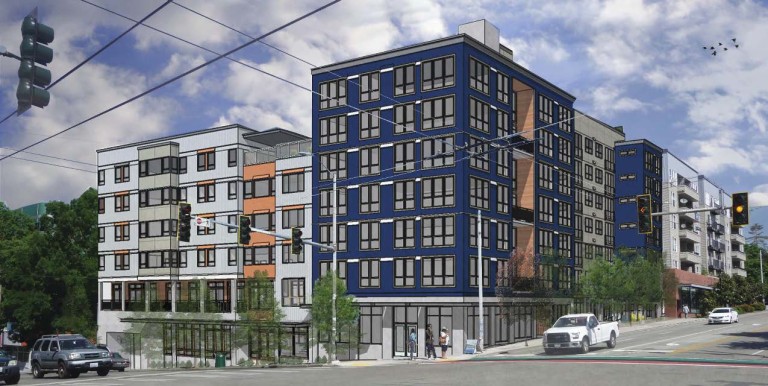For Chris Szala, executive director of Community House Mental Health Agency, which will be housed in the new development, the demand was more intense “by far” than at any other point in his 30-year career in housing development.
“Seattle has become so unaffordable in so many ways that many of my staff could be eligible to live there,” he said.
Judkins Heights will be a first for Seattle: Half of its 74 units are reserved for people who’ve been pushed from the historically Black Central District. This so-called “neighborhood preference” policy — modeled after an approach used in northeast Portland — asks residents to prove they lived in the Central District before the year 2000. At $800 for a studio and $1,100 for a two-bedroom, these apartments are not targeted toward the city’s poorest residents, but toward those who a decade ago may have lived comfortably in the area without needing subsidized rent. But apartments priced that low are nearly extinct on the open market now. At the heart of the once-majority Black area, the demand is a symbol of the neighborhood’s changes and the barriers faced by residents who may wish to return to where they once lived.

Seattle is building more affordable housing now than it ever has. Late last year, Mayor Jenny Durkan announced the city would end 2019 having invested over $110 million on new construction and renovation of nearly 2,000 subsidized apartments. That’s more than the city has ever spent, thanks largely to a beefed up property tax measure, sales tax revenue from the state, the sale of a South Lake Union property and healthy revenue from taxing real-estate transactions.
The units are a mix of workforce housing, for individuals earning less than $60,000 a year or families earning less than $90,000, and more deeply subsidized housing, for people near or below the poverty line.
City, county, state and federal investments produced between 1,000 and 2,500 units a year in King County from 2012 to 2018, according to a 2018 report from the regional affordable housing task force, made up of local elected officials and supporting staff.
Yet that same task force concluded that King County needs 156,000 additional affordable places to live today, escalating to 244,000 by 2040.
The Judkins project on South Jackson Street began as a place for people experiencing homelessness, many coming from a hospital or jail. The offices of the nonprofit Community House Mental Health Agency, which works with people with severe and persistent mental illness, had been on the site since 2012. With the property’s redevelopment, the nonprofit will get new offices there and, above them, 53 new apartments for its clients.
But Szala said they did not want to create an “island” of extremely poor people in a sea of new wealth. And so, it opted to expand the development to add 74 units for workforce housing.
“To have a healthy community, you’ve got to have all those levels of housing,” said Szala.
For outreach, the staff posted information online and, for a short time, they hung a lease sign on the new building, at the northwest corner of 23rd Avenue South and South Jackson. They also spoke in nearby churches whose congregants often travel from the suburbs to attend Sunday services they grew up with. Additionally, they did outreach in Renton, Kent and other neighboring cities to which many longtime Central District residents have moved.
Africatown Media Network, which works for community ownership of land in the Central District, also conducted outreach via telephone calls, in churches, at little league games, videos and more. Omari Salisbury of Africatown called it a "full court press on awareness around the building.
Szala said he’s not surprised by the response. Reaction was strong, he said, especially among young people who may have gone to nearby Garfield High School and always envisioned continuing to live in the city.
No other housing developments have come with such an explicit “neighborhood preference.” But Szala said that because it’s not about race or any other protected class and because half the apartments will be doled out in an open lottery, he’s confident it passes the “smell test” of what’s allowed. It was well vetted by numerous agencies beforehand and all agreed it was OK, he said.
By next week, all 74 apartments will be assigned. The building is set to open in March.
This article has been updated to reflect Africatown's outreach efforts.


